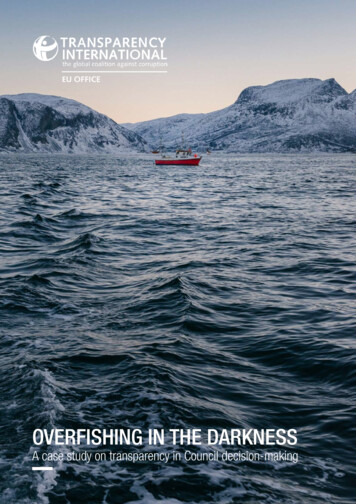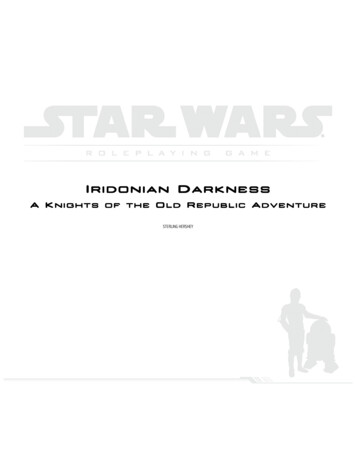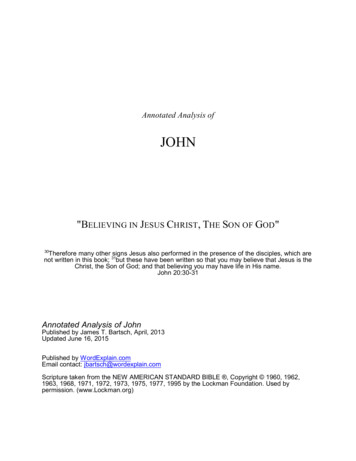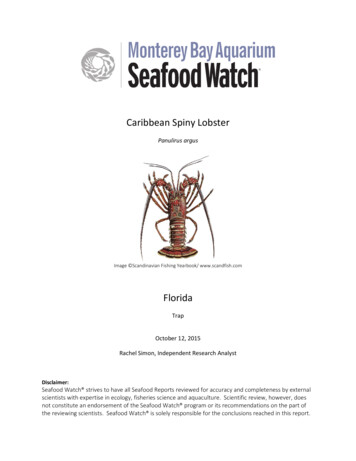
Transcription
OVERFISHING IN THE DARKNESSA case study on transparency in Council decision-making
Transparency International EU is part of the global anticorruptionmovement, Transparency International, which includes over100 chapters around the world. Since 2008, TransparencyInternational EU has functioned as a regional liaison office forthe global movement and as such it works closely with theTransparency International Secretariat in Berlin, Germany.Transparency International EU leads the movement’sEU-focussed advocacy, in close cooperation with nationalchapters worldwide, but particularly with the 25 nationalchapters in EU Member States.Transparency International EU’s mission is to prevent andaddress corruption and promote integrity, transparency andaccountability in the EU institutions and in EU internal andexternal policies, programmes and legislation.Author: Yannik BendelPhoto credits in order of appearance:Cover photo: unsplash.comPage 11: European Union, 2016Page 12: unsplash.comPage 14: Paulo Valdivieso via Flickr/PauloValdiviesoPage 17: European Union 2015, adapted from the original.Page 20: European Union 2015page 23: unsplash.comEvery effort has been made to verify the accuracy of the information contained in thisreport. All information was believed to be correct as of September 2016. Nevertheless,Transparency International EU cannot accept responsibility for the consequences of its usefor other purposes or in other contexts.Printed on 100% recycled paper. 2016 Transparency International EU. All rights reserved.2Transparency International
TABLE OF CONTENTSExecutive SummaryIntroductionTransparency in the Council of the European UnionThe Case for Greater TransparencyCase Study: Murky WatersCouncil Negotiations on Fishing OpportunitiesThe Political Challenges of Council Decision-MakingResults of Transparency International’s QuestionnaireObservations & RecommendationsAcronymsReferencesOverfishing in the darkness04070810141618222933343
EXECUTIVE SUMMARYFor centuries the seas of north-western Europe have been a source ofwealth for coastal communities and there has been a huge expansionof fisheries in pursuit of food and profit. Over the few last decades,however, continued overfishing has had serious consequences for theenvironment, peoples’ jobs and the food we eat. In the North EastAtlantic and Baltic Sea half of all fish stocks are subject to overfishingand 61 per cent are below biologically safe limits.1 The sustainabilityand viability of fish stocks is under threat. Part of the problem is thatEuropean fisheries ministers set annual fishing limits that are in manycases above scientifically advised levels year after year in the Councilof the European Union (referred to henceforth as ‘the Council’). Thesedecisions are made behind closed doors with little or no accountabilityand have real and damaging impacts on our lives.This report closely examines the state of transparency and accountabilityof the Council around the annual negotiations on fishing quotas in theFisheries Council (AGRIFISH). It looks at the appetite of EuropeanUnion (EU) Member States for reform and suggests best practices fortransparent decision-making.This study comes at a moment when, for the first time in history of theEU, the citizens of a Member State have voted to leave the Union –forcing governments to revisit the very foundations and democraticgovernance structures of the EU. With multiple parallel crises in theareas of migration, terrorism, environmental degradation and in the faceof rising Euroscepticism, the EU is in dire need of good governance andbroad public support to address future challenges. Transparent andaccountable EU institutions are seen to be an essential component inrebuilding the democratic legitimacy of decision-making and to preventthe kind of policies that lead to problems like overfishing.In this context the Council has been identified as a priority for reform.Whereas the European Parliament, European Commission and a numberof national governments are already operating under stricter transparencyand disclosure obligations, it remains virtually impossible for citizens tounderstand how deals are made in the Council. Finding out whether theirrepresentatives were in favour or against a certain provision is challengingand stands in the way of holding members to account. Led by a numberof influential Member States, there has been considerable reluctanceto commit to any reforms and to implement concrete improvements toincrease transparency and accountability. A closer look reveals that thecurrent legal framework would easily allow to go much further – but thesepossibilities are not used in practice.Our case study on the annual EU negotiations on fishing quotas showsthat the lack of transparency and accountability can have real anddetrimental effects on the quality of decisions. Despite the recent reformof the Common Fisheries Policy, overfishing and depletion of EU fishstocks is continuing at alarming rates. Narrow national interest politics,politicians’ self-interest in getting re-elected and the influence of lobbyistscurrently all stand in the way of sustainable fishing, which is in the longterm interest of all parties involved.4Transparency International
The results of this study confirm that the Council is lagging a long waybehind other EU institutions in terms of transparency. The report presentsthe results of a questionnaire among Member States on their positionsto increase the transparency of AGRIFISH negotiations in particular andthe Council more generally. Only a small number of Member States havecome out in favour of ambitious reform. At the same time, the repliespoint to a number of best-practice examples and promising ideas forpractical next steps. Among other things, the potential role of nationalparliaments to increase transparency and democratic accountability hasbeen emphasised. A number of governments already provide writteninformation to their parliament in the run-up to all meetings. These‘annotated agendas’ provide an overview of the topics to be discussedand, in some cases, reveal the negotiating position of other MemberStates and the EU institutions. In the Netherlands and Sweden, forexample, these documents are publicly available. However, this alonecannot replace the direct accountability of the Council towards EUcitizens.Citizens in all EU Member States have the same rights and should haveequal access to information and should be able to understand whattheir government is doing in their name in Brussels. Any future reformprocess should be guided by a clear commitment to more transparencyin Council decision-making and should translate into tangible, concretesteps towards reform. With this in mind, Transparency International EUhas compiled a number of practical recommendations that address bothCouncil decision-making in general and the specific case of the AGRIFISHCouncil (for a more detailed list of recommendation, see Observations &Recommendations at the end of the report).Overfishing in the darkness5
RECOMMENDATIONSIncrease the transparency and accountability of the CouncilThe existing legal framework should be fully followed to release moredetailed, meaningful and timely information at each stage of thedecision-making procedure (Working Parties, Committee of PermanentRepresentatives (COREPER) and Council). This includes the publicationof more detailed results/minutes, detailed information on MemberState negotiating positions – ideally before compromises have beenreached or votes have been held – as well as an overhaul of the accessto information policy of the Council to comply with legal obligations.Moreover, live-streaming should be extended to all Counciland COREPER debates with limited exceptions Best practice intransparency should be generalised at each stage of the decisionmaking procedure and across different Council configurations.Become a full member of the EU Transparency RegisterThe Council should finally follow suit to participate in the Joint TransparencyRegister between the European Parliament and the EuropeanCommission. This would mean that unregistered lobbyists shouldnot be able to arrange meetings or access buildings. Permanentrepresentations of Member States as well as the rotating presidencyshould also pledge that they will no longer meet with unregisteredlobbyists – both in Brussels and in national capitals. To enable the publicto monitor the implementation of the above principle, the Council shouldpublish details of meetings with lobbyists, as is current practice forthe European Commission. The Council should publish all written inputby lobbyists in a central location to allow the establishment of an EULegislative Footprint in a joint database with the European Parliamentand Commission.Make AGRIFISH Council negotiations on fishing opportunitiestransparent and accountableThe general demands to increase the transparency and accountability ofthe Council decision-making process outlined above also apply for theAGRIFISH Council. Specifically, this includes making all scientific andsocio-economic evidence used in negotiations open to public scrutinyand to allow live-streaming of the ministers’ exchange of views.6Transparency International
INTRODUCTIONThe Council of the European Union (henceforth ‘the Council’) is not onlyone of the most powerful institutions in the EU legislative process, it isalso the most opaque EU institution. While in theory the Council is onequal footing with the European Parliament, in practice it often has thefinal say on European legislation. It also retains exclusive competence insome policy fields and acts much as an upper chamber would in otherpolitical systems. In its role as co-legislator and executive body, theCouncil takes decisions on all EU legislation – whether through amendingCommission proposals, adopting or blocking legislative proposals. TheCouncil’s decisions affect the daily lives of 500 million EU citizens.Unfortunately, however, the Council does not have the best trackrecord of ensuring accountability in its proceedings, especially whencompared to other EU institutions. This reputation has been reinforcedby its reluctance to comply fully with the 2013 Court of Justice of the EU(CJEU) ruling,2 which required the Council to make its deliberations muchmore transparent.3At a time of markedly declining public trust in all the EU institutions,4 withmany citizens fearing that decisions taken behind closed doors are notin their best interest, perceived secrecy can undermine support for theEU project. Opaque Council negotiations are, of course, not the onlyproblem in this regard. However, by making Council decision-makingmore transparent and by showing clear links between decision-makersand their decisions some of the lost trust may be regained.The political call to increase the transparency of EU institutions, includingthe Council, is not new. The December 2001 Laeken Declaration5 alreadyincluded several important paragraphs on making the EU more open,transparent and accountable. EU leaders also understood the inherentconnection between the transparency of EU institutions, the democraticlegitimacy of the EU and the future of the EU project:“The European Union derives its legitimacy from the democratic values itprojects, the aims it pursues and the powers and instruments it possesses.However, the European project also derives its legitimacy from democratic,transparent and efficient institutions. [ ] The first question is thus how wecan increase the democratic legitimacy and transparency of the present institutions, a question which is valid for the three institutions.”More than a decade and a half later, the European project seems to be at acritical turning point. Several crises and declining public support for moreEU integration have underlined that the European project indeed derivesits legitimacy from democratic, transparent and efficient institutions. Thecase for reform is now more pertinent than ever. However, it is not clearto what extent there is still political willingness among Member States’representatives to prioritise and push for substantial transparency reform.With the other EU institutions have made progress towards greatertransparency, the blind-spot of EU decision-making clearly lies in theCouncil.Overfishing in the darkness7
Over recent years, Transparency International EU has closely followed thereform processes of EU institutions and has worked to provide practicalrecommendations. In 2014, we published the first ever comprehensiveassessment of the EU’s main political institutions – The European UnionIntegrity System report.6 This report was complemented in 2015 by an indepth study, Lobbying in Europe,7 which focused specifically on lobbyingregulation across Europe and for the three core EU institutions.Against this background, Transparency International EU has set outto take a renewed look at Council decision-making and the possibilityfor reform. The current study has two objectives: (1) to take stock ofMember States’ position on Council transparency; and (2) to come upwith concrete and practical recommendations for reform. As part ofa nine-month project, entitled Overfishing in the darkness,8 we chosethe annual negotiations on fishing opportunities in the Agriculture andFisheries Council (AGRIFISH) as a case study to explore to what extentMember States would be willing to enhance transparency. This report isintended to summarise the findings of this project.TRANSPARENCY IN THE COUNCILOF THE EUROPEAN UNIONTransparency in decision-making is commonly understood as the totalityof provisions in place to ensure that the public can obtain relevant andtimely information about the activities and processes that provide thebasis for these decisions. The aim of this is that the public can understandhow and why decisions are made in order to monitor and participate inthe process. In order for this to be effective, a basic level of transparencyis needed. This means that structural information – like timelines of theprocess, agendas of the meetings, participants’ lists and composition ofgroups – need to be available to the public. Likewise, details of what isbeing discussed and the different positions and proposed compromisesshould also be publicly available. Documents of this kind include annotatedminutes, briefings and notes summarising discussions, Member States’positions, tabled amendments, compromise proposals, other (working)documents, studies and voting/negotiation results (by Members).All of these documents and written records are a way to allow outsidersto reconstruct the decision-making process. Access to this informationcan also be granted through opening up the deliberation process throughpublic sessions via live-streaming or public access to the discussions.As Transparency International EU has previously pointed out9, the Councilhas the basic infrastructure in place to manage and make informationabout the decision-making process accessible. The Council maintains arelatively well-structured database10 for storing documents and recordingdata on public document requests. The ‘Open Sessions’ page11 on theCouncil’s website allows viewing of those Council sessions that areopen to the public via live-streaming. Two sets of Council minutes –one relating to general matters and another specifically concerning theadoption of legislative acts – are accessible online. The Council websitehosts an online archive of public voting results. Monthly summaries oflegislative acts of the Council are also available online. As part of theInter-Institutional Agreement (IIA) on Better Regulation, the Council (incooperation with the other main EU institutions) is currently developing8Transparency International
a system on the EU’s legal document depository, EUR-Lex, where thepublic can access visual depictions (such as timeline representations) ofthe life-cycle of legislative proposals and individual institutional input.12Despite all of the above-mentioned provisions, the Council still lacks abasic level of transparency in the decision-making process that wouldallow citizens, civil society organisations or other stakeholders to betterunderstand how decisions are taken and thus allow them to hold theirrepresentatives to account.This is despite the ruling of the EU Court of Justice of 17 October 2013on Council vs. Access Info Europe, which underlined that the Councilcan and has to do more to fulfil the transparency obligations laid out inthe treaties. The European Parliament, as the co-legislator, has alreadydemonstrated that it is possible to successfully operate under strongertransparency provisions. In the European Parliament, Committee meetingsare live-streamed online, as are the plenary session. Minutes and plenaryvoting records also allow the public to see which Member supportswhich policies. The Commission has also started a transparency initiativein 2014, making strong commitments to increase lobbying transparency.Since 1 December 2015, Commissioners, their Cabinets and DirectorGenerals publish their meetings and only meet with lobbyists registeredin the Joint Transparency Register (JTR) of the EU. By increasing itstransparency provisions, the Council would, therefore, not be venturinginto uncharted territory; on the contrary, it would simply be followingwhat other institutions have already been doing for years.The opacity of so-called ‘trilogue meetings’ is emblematic of the continuingproblem of a lack of Council transparency and the special status of theCouncil. Trilogues are informal working meetings between the EuropeanParliament, the Council and the Commission aimed at speeding up theordinary legislative process. During these meetings, large concessionsare often won and lost with currently very little oversight and withoutpublic disclosure. During the last legislative term, more than 1,500trilogue meetings were held, which allowed roughly 85 per cent13 of lawsto be agreed at a first reading. Since trilogue negotiations have becomethe new normal in EU law-making, the same transparency provisionsshould apply to them as for the rest of the legislative process. Currently,the negotiating positions of the other two institutions are mostly known,and the compromises will also be made public eventually. However, theposition of the Council and that of its Member States remains opaque.Acknowledging the problem, the European Ombudsman, Emily O’Reilly,recently published recommendations calling for more transparencyaround these informal negotiations.14Furthermore, the Council is currently the only core EU institution thatdoes not participate in the EU Transparency Register, despite being aroutine target for corporate lobbyists and other interests. Currently, nocontact between third parties and Council members is systematicallyrecorded or disclosed so it is impossible to check the extent of thirdparty input.Overfishing in the darkness9
THE CASE FOR GREATER TRANSPARENCYTransparency International EU acknowledges that some degree ofconfidentiality in negotiations is necessary. However, we stronglybelieve that more publicly available information and more opennessof the institutions are both essential prerequisites for fair stakeholderparticipation, protecting the public interest and ensuring democraticaccountability. This will ultimately help lead to better policies and greaterdemocratic legitimacy of EU decision-making, which could help to bringthe EU institutions closer to its citizens and contribute to a “Union ofDemocratic Change”.15 Apart from this, more transparency is also vital tocomply with the spirit of the Treaty on European Union (TEU).A MATTER OF FAIR STAKEHOLDER PARTICIPATIONTransparency International EU firmly believes that greater transparencyand greater diversity in stakeholder input into the legislative process canlead to more balanced policy decisions that represent broader interestsand would ultimately lead to better outcomes. A transparent legislativeprocess is the best and easiest way to ensure “better regulation”. Itwould enable greater understanding of the decision-making processamong stakeholders and eliminate information asymmetries created bythe privileged access of some actors. Involvement and dialogue with civilsociety in EU decision-making is stipulated in Article 11 of the EU treaty,which states that good governance requires the institutions to ensureparticipation and debate with civil society.A MATTER OF PROTECTING THE PUBLIC INTERESTSecrecy in decision-making fosters undue influence. Well-connected andwell-resourced lobbyists are often fully aware of the negotiations takingplace behind closed doors and manage to feed in their recommendationsand demands. Much of the influence remains hidden and informal andcertain groups enjoy privileged access to decision-makers. Those withless money and connections cannot follow the process and only becomeaware of the state of the discussions after a deal has been struck – oftenwhen it is too late to make any further changes. Citizens and interestgroups have little opportunity to know who is influencing public decisions,on what issues and how. As a consequence, many citizens fear thatdecisions taken behind closed doors are not taken in their best interest.Over the last decade, researchers have collected evidence that publictrust in the EU institutions is declining. Increasing transparency wouldpartly mitigate risks of undue influence and domination of policy-makingby special interest groups. It would also provide citizens and otherstakeholders with better opportunities to participate in the legislativeprocess and to monitor whether policies are truly made in the publicinterest. This could ultimately help to restore part of the public trust thathas been ebbing away over recent times.10Transparency International
A MATTER OF RIGHTSThe principle of transparency and citizen participation is enshrined inArticle 1 of the TEU, which states that “in the process of creating anever closer union among the peoples of Europe, [.] decisions are takenas openly as possible and as closely as possible to the citizen”.20 Thisapplies to all stages of the legislative process. The Treaties explicitlyspell out that the European Parliament (Art. 15(2) TEU) and the Council(Art. 16 (8) TEU), as the two co-legislators, are obliged to meet in publicwhen considering and voting on a draft legislative act. These generalprinciples are confirmed in Article 10 (3) TEU, which states that everycitizen has the right to participate in the democratic life of the Union.This has been confirmed by several court rulings underlining that thetransparency and openness of the process is essential to understandinghow and why a decision has been taken, and is thus “a precondition forthe effective exercise of their democratic rights”.21 Making the legislativeprocess transparent is thus a question of fundamental principles for theEU, as well as being a basic democratic rights for EU citizens.processtransparent is thus a question of fundamental principles of the EU as wellas basic democratic rights of EU citizens. European Union, 2016Overfishing in the darknessPicture of a Trilogue meeting in the Council Photo credits: XXX11
No direct accountabilityThe Council of the European UnionDirect accountabilityEuropean ParlimentNational representativesin CouncilEU levelLong chain of accountabilitymandatesNatinonal MinistryoverseesNatinonal Ministerselect directlyappointsHead of GovernimentelectsNational ParlimentelectsNational levelNational electorate12EU citizensPhoto from: unsplash.com
A MATTER OF DEMOCRATIC ACCOUNTABILITYLack of transparency can also stand in the way of accountable decisionmaking. Without all the relevant information, it is difficult for citizens or theirrepresentatives in national parliaments to fully understand which positiontheir politicians are defending in their name and to hold them accountablefor it. This lack of transparency gives decision-makers the opportunityto deny responsibility for decisions that they clearly supported. In thecontext of the EU, this can have another adverse effect, when politiciansuse the EU institutions as a scapegoat for unpopular decisions at home.As it is difficult to check individual Member State positions, it is easy forministers to return to their countries and claim the opposite of what theyhave themselves decided in Brussels. This can seriously undermine thecredibility of EU politics and can help to fuel Euroscepticism.One of the problems with the accountability of Council decision-making inthis regard is the length of the ‘accountability chain’. According to Article10 (1) TEU, citizens are indirectly represented by their governments inthe Council. Article 10 (2) recognises the democratic accountability ofthe Council of Ministers and the European Council. As Member States’positions remain opaque and the negotiation mandate in many cases istransferred further, accountability can become weak. Figure 1 depictsthe different intermediate steps of the accountability chain:Due to the current lack of transparency, there is very little possibility forthe national electorate in EU Member States to hold decision-makersin the Council directly to account. This is currently the role of nationalparliaments, which are tasked – as recognised in the Amsterdamprotocol17 – with monitoring and checking what is decided in theCouncil on the basis of the principle of subsidiarity. In addition, moretransparency of the decision-making process could strengthen bothdirect accountability – linking the governing to those who are governed –as well as the indirect accountability channel through national parliaments.In a number of Member States, for example, it is already best-practicethat the government sends so-called ‘explanatory notes’ before andafter meetings in the Council to their national parliament to brief themon the progress of the negotiations. In practice the level of detail variessubstantially between different EU countries – from being completelynon-existent to including different Member States’ positions.18 For afew countries these notes are also made public on a freely accessibledatabase of the parliament (for example, in the Netherlands, the UK andSweden as well as other).19Overfishing in the darkness13
CASE STUDY: MURKY WATERSThe annual Council decisions on setting fishing limits in EU waters are asticking point that highlights the lack of transparency in the Council. Civilsociety organisations have repeatedly complained that the public interesthas not fully been reflected in the final decision of ministers, as well ashighlighting how such decisions have led to serious mismanagement ofa public resource.22 For this reason, it is a good case study to betterunderstand the dynamics of Council decision-making and how greatertransparency could help to overcome some of the persistent problems.Fish stocks are a public resource and should be managed in the publicinterest. Yet, many fishing limits set annually by EU fisheries’ ministersregularly exceed scientifically advised levels. While most decision-makersagree that overfishing has a negative long-term impact, they too oftenfavour the short-term interests of the fishing industry over longer-termsustainability of fish stocks for the whole of the EU.2314TransparencyInternational Flickr- Paulo Valdivieso
THE EVIDENCE OF OVERFISHINGResearch recently published in the Journal of Marine Policy andfeatured in Nature shows that, while EU ministers head into negotiationswith scientific advice in hand, over the past 15 years they have beenexceeding the advised fishing levels by 20 per cent, on average. Thisholds true even after the reformed Common Fisheries Policy (CFP) wasintroduced in 2013 (see below). Although overfishing has declined overthe past decade, in 2014 (the last year for which data is available) aworrying reversal of this trend can be seen. According to the EuropeanCommission’s scientific body – the Scientific, Technical and EconomicCommittee for Fisheries (STECF) – the average level of overfishing for2014 was 27 per cent — more than a quarter above the scientificallyadvised Total Allowable Catches (TACs), as the following figure shows.See next section for more information on TACs.FIGURE 2:AVERAGE LEVEL OF OVERFISHING IN THE EUROPEAN UNION* (F 142013201220112010200920082007200620052004200322% 18%0%*Northeast Atlantic (FAO 27), including Western European Waters, North Sea and Baltic SeaSource: Scientific, Technical and Economic Committee for Fisheries,“Monitornig the performance of the Common Fisheries Policy (STECF-16-05)”. March 2016 2016 The Pew Charitable TrustsThe latest analysis, based on data from 2014, suggests that 47 per centof fish stocks were subject to overfishing and 61 per cent of stocks werebelow biologically safe limits in the Northeast Atlantic, including the BalticSea.26Overfishing in the darkness15
The political framework in the field of fisheries policies has changedsignificantly over time. In 2011, after decades of overfishing, whichresulted in an unprofitable EU fleet and most fish stocks in bad shape,the European Commission presented a proposal for a major reformof the CFP. One of main objectives of the reform, which was formallyadopted in 2013, was to ensure sustainable fishing limits – that is, to endoverfishing and also, importantly, to allow stocks to recover to healthylevels. The new CFP includes a legal requirement to cease overfishingby 2015 where possible, and by 2020 at the latest for all stocks. Overall,however, the numbers on overfishing seem to offer compelling evidencethat – even though the CFP includes clear legal obligations and acommitment to sustainable fishing – overfishing has not ended and thereis some indication that ministers are trying to further delay the process.So what is the underlying re
Overfishing in the darkness 5 The results of this study confirm that the Council is lagging a long way behind other EU institutions in terms of transparency. The report presents the results of a questionnaire among Member States on their positions to increase the transparency of AGRIFISH negotiations in particular and the Council more generally.










